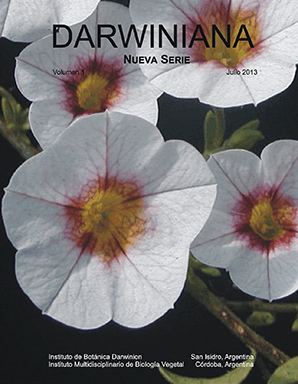First results about Pre-Hispanic use of the plant resources in Los Tres Cerros 1 archaeological site (Victoria, Entre Ríos, Argentina): biosiliceous record analysis
DOI:
https://doi.org/10.14522/darwiniana.2013.12.541Keywords:
Anthropic mounds, Argentinean Mesopotamia, biosiliceous microremains, Late Holocene, phytolithsAbstract
The biosiliceous microfossil record has a high preservation degree in different natural and cultural contexts. For that reason, the study of phytoliths and other siliceous microremains may contribute both to infer environmental conditions of local plant communities that surrounded an archaeological site, and to identify plant species with anthropic use. We analized phytoliths and other siliceous microremains from a profile of Tres Cerros 1 archaeological site (LTC1, Las Moras Island, Victoria Department, Entre Ríos, Argentina) and other collected samples from particular features observed during excavation of the site. The bio-siliceous microfossil analysis revealed elements related to both wild plant resources from the present phytogeographic unit, and cultural plant management of species related to Arecaceae, Cucurbitaceae, and Poaceae (subfamilies Maideae and Oryzoideae). The bio-siliceous microfossil record of the LTC1 profile has a clear change between baseline and the top of the anthropic depositional unit, which can be correlated with different activities during the construction process of the mound, which took place between ca. 1000 - 500 years 14C BP.
Published
How to Cite
Issue
Section
License

Starting on 2012, Darwiniana Nueva Serie uses Licencia Creative Commons Atribución-NoComercial 2.5 Argentina .






